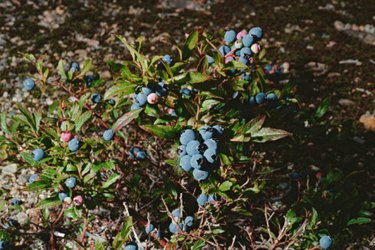Things You'll Need
Soil pH testing kit
Sulfur
Tiller
Shovel
Peat moss
Scissors
Soaker hose
Organic mulch
Ammonium sulfate fertilizer

Originating from North America, blueberry bushes are popular fruit crops easily grown in areas in Kentucky. While highbush varieties thrive in most parts of the state, Reade blueberries grow in southern parts. According to the University of Kentucky, the yield of these purple-blue berries in some farms exceeds 8,000 lbs. per acre, which is considered highly productive. The perennial shrubs prefer well-draining, slightly acidic soils, so amend the soil to give your crop a good start and the nutrients they need.
Step 1
Test the pH of the selected site with a testing kit. Blueberry plants prefer well-drained, organic soils with a pH of 4.4 to 5.2. Add sulfur to the top 2 to 3 inches at least two months before planting. Till the soil the amendment goes deep down. You need 3 to 7 lbs. of sulfur for every 100 square feet.
Video of the Day
Step 2
Dig a 2-foot-deep and 1 1/2-foot-wide hole over the amended spot with a shovel in late fall after the danger of frost has passed or in early spring before the start of new growth. Dig rows of identical holes spaced 10 feet apart, and space holes 4 feet apart.
Step 3
Add 1 gallon of moist peat moss to the base of every hole to increase organic content and improve blueberry growth. Add soil back to the holes until 4 inches below the top.
Step 4
Cut damaged parts of roots and spindly wood of a plant after removing it from its nursery container. Lower the plant into the hole and spread its roots in all directions. Make sure you plant the blueberry at the same depth as its nursery container. Backfill each hole with soil and tamp it down.
Step 5
Irrigate the base of the plant thoroughly to help the soil settle down. Spread a 3- to 4-inch-thick layer of organic mulch around the base of each blueberry plant, spaced 3 inches from the base. Reapply mulch every one to two years.
Step 6
Water the blueberry plants every seven to 10 days to provide them 1 to 2 inches of water. Use a soaker hose that provides water to the roots.
Step 7
Pinch off any berries that appear on the first or second years to reserve the plants energy for higher productivity in subsequent years. Prune blueberry bushes regularly to invigorate growth and maintain size. Prune the plant in early spring, before bud break. Remove damaged, diseases, overlaying and crossing limbs.
Step 8
Fertilize each blueberry at bloom and six weeks later using 0.1 lb. of ammonium sulfate. In subsequent years, increase the amount of fertilizer at the same timing by 0.1 lb. every year, until you apply 0.3 lb. of fertilizer per plant.
Tip
Plant a mix of early, mid and late season blooming varieties to prolong harvest. Consider planting ‘Spartan’ for an early harvest; ‘Sierra,’ ‘Bluecrop’ and 'Toro’ for a mid-season harvest; and ‘Darrow’ or ‘Nelson’ for a late-season harvest.
Video of the Day